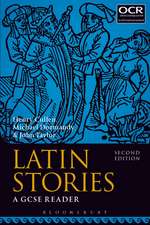An Introductory Sanskrit Reader: Improving Reading Fluency
Autor Antonia M. Ruppelen Limba Engleză Paperback – 17 noi 2021
When we study ancient languages, there often is quite a gap between introductory, grammar-based classes and independent reading of original texts. This Reader bridges that gap by offering complete grammar and vocabulary notes for 40 entertaining, thought-provoking or simply beautiful passages from Sanskrit narrative and epic, as well as over 130 subhāṣitas (epigrams).
These readings are complemented by review sections on syntax, word formation and compounding, a 900-word study vocabulary, complete transliterations and literal translations of all readings, as well as supplementary online resources.
The Reader can be used for self-study and in a classroom, both to accompany introductory Sanskrit courses and to succeed them.
Preț: 377.63 lei
Nou
Puncte Express: 566
Preț estimativ în valută:
72.26€ • 75.85$ • 59.98£
72.26€ • 75.85$ • 59.98£
Carte disponibilă
Livrare economică 21 martie-04 aprilie
Preluare comenzi: 021 569.72.76
Specificații
ISBN-13: 9789004468665
ISBN-10: 9004468668
Dimensiuni: 215 x 289 mm
Greutate: 0.79 kg
Editura: Brill
Colecția Brill
ISBN-10: 9004468668
Dimensiuni: 215 x 289 mm
Greutate: 0.79 kg
Editura: Brill
Colecția Brill
Notă biografică
Since receiving her Ph.D. from the University of Cambridge, Antonia M. Ruppel has taught Sanskrit at Cornell, Oxford and the LMU Munich. The recipient of several awards for her teaching, she is the author of the 2017 Cambridge Introduction to Sanskrit.
Cuprins
Acknowledgements
Read Me! A Brief Introduction You Won’t Want to Miss
How to Do More With Words: Building Up Your Sanskrit Vocabulary
Beginning to Read Sanskrit: Some Practical Tips for English Speakers
Annotations and Abbreviations
1 Hitopadeśa, or Supportive Advice
aThe Dog, the Donkey and the Thief (2.2)
bThe Lion, Mouse and Cat (2.3)
cThe Clever Woman and the Bell (2.4)
dThe Clever Woman with Two Lovers (2.6)
eThe Lion and the Old Hare (2.8)
fThe Elephant, the Hares and the Moon (3.3)
gThe Blue Jackal (3.7)
hThe Sage and the Mouse (4.5)
iThe Old Crane and the Crab (4.6)
jThe Brahmin and the Pots (4.7)
kThe Two Demons (4.8)
lThe Brahmin and the Three Crooks (4.9)
2 Vikramacarita, or Vikrama’s Deeds
aI Volunteer as Tribute (Story 8)
bEight Jewels from Eight Goddesses (Story 21)
cKing Vikrama in His Element (Story 22)
dDon’t Believe Everything You See (Story 30)
3 Rāmāyaṇa, or Rāma’s Journey
aThe Beauty of the Night (1. 33.14–18)
bA Perfect Leader (2.1.15–28)
cA Land Without Leadership (2.61.8–23)
dJābāli the Materialist on the Meaning of Life (2.100.1–17)
eSītā Cautions Rāma on the Handling of Weapons (3.8.1–12, 20–29)
fRāma Asks Nature If It Has Seen Sītā (3.58.1–22, 31–34)
gThe Ascetic Śabarī (3.70.4–27)
hThe Hermitage of the Seven Sages (4.13.12–27)
iTārā Counsels Her Husband Vālin (4.15.7–23)
jTārā Laments Her Husband Vālin (4. 20.12–17)
kThe Rainy Season (4.27.2–46)
lSvayaṃprabhā’s Cave (4.49.12–52.13)
mHanumān Learns about His Immaculate Conception (4.65.8–28)
nHow Should I Address Sītā? (5.28.3–44)
4 Kathāsaritsāgara, or Ocean of Rivers of Stories
aŚiva Explains the Significance of Skulls (1.2.10–15)
bBrahmadatta and the Golden Swans (1.3.27–34)
cPāṇini (1.4.20–25)
dHand with Five Fingers, Hand with Two Fingers (1.5.8–12)
eWhy the Fish Laughed (1.5.14–25)
fKing Śibi Sacrifices Himself (1.7.88–97)
gHow the Bṛhatkathā Came to Earth (1.8.1–38)
hAhalyā: Bilingual and Clever (3.3.137–147)
iBuddhist Merchant, Hindu Son (6.1.11–54)
jThe Brahmin and the Outcaste (6.1.123–133)
kThe Seven Princesses: King Kaliṅgadatta Is Told a Story within a Story within a Story (6.2.9–45)
lTapodatta Tries to Replace Study with Penance (7.6.13–24)
mShould You Turn a Mouse into a Girl? (10.6.125–135)
nOnce You’ve Tasted the Good Stuff … (10.6.178–185)
oGuard the Door! (10.6.209–211)
5 Bṛhatkathāślokasaṃgraha, or Verse Summary of the Great Story
6 Subhāṣitas, or Epigrams
Appendix 1: Roman Transliteration of All Texts
Appendix 2: Literal Translations of All Texts
Appendix 3: Study Vocabulary
Read Me! A Brief Introduction You Won’t Want to Miss
How to Do More With Words: Building Up Your Sanskrit Vocabulary
Beginning to Read Sanskrit: Some Practical Tips for English Speakers
Annotations and Abbreviations
The Readings
1 Hitopadeśa, or Supportive Advice
aThe Dog, the Donkey and the Thief (2.2)
bThe Lion, Mouse and Cat (2.3)
cThe Clever Woman and the Bell (2.4)
dThe Clever Woman with Two Lovers (2.6)
eThe Lion and the Old Hare (2.8)
fThe Elephant, the Hares and the Moon (3.3)
gThe Blue Jackal (3.7)
hThe Sage and the Mouse (4.5)
iThe Old Crane and the Crab (4.6)
jThe Brahmin and the Pots (4.7)
kThe Two Demons (4.8)
lThe Brahmin and the Three Crooks (4.9)
2 Vikramacarita, or Vikrama’s Deeds
aI Volunteer as Tribute (Story 8)
bEight Jewels from Eight Goddesses (Story 21)
cKing Vikrama in His Element (Story 22)
dDon’t Believe Everything You See (Story 30)
3 Rāmāyaṇa, or Rāma’s Journey
aThe Beauty of the Night (1. 33.14–18)
bA Perfect Leader (2.1.15–28)
cA Land Without Leadership (2.61.8–23)
dJābāli the Materialist on the Meaning of Life (2.100.1–17)
eSītā Cautions Rāma on the Handling of Weapons (3.8.1–12, 20–29)
fRāma Asks Nature If It Has Seen Sītā (3.58.1–22, 31–34)
gThe Ascetic Śabarī (3.70.4–27)
hThe Hermitage of the Seven Sages (4.13.12–27)
iTārā Counsels Her Husband Vālin (4.15.7–23)
jTārā Laments Her Husband Vālin (4. 20.12–17)
kThe Rainy Season (4.27.2–46)
lSvayaṃprabhā’s Cave (4.49.12–52.13)
mHanumān Learns about His Immaculate Conception (4.65.8–28)
nHow Should I Address Sītā? (5.28.3–44)
4 Kathāsaritsāgara, or Ocean of Rivers of Stories
aŚiva Explains the Significance of Skulls (1.2.10–15)
bBrahmadatta and the Golden Swans (1.3.27–34)
cPāṇini (1.4.20–25)
dHand with Five Fingers, Hand with Two Fingers (1.5.8–12)
eWhy the Fish Laughed (1.5.14–25)
fKing Śibi Sacrifices Himself (1.7.88–97)
gHow the Bṛhatkathā Came to Earth (1.8.1–38)
hAhalyā: Bilingual and Clever (3.3.137–147)
iBuddhist Merchant, Hindu Son (6.1.11–54)
jThe Brahmin and the Outcaste (6.1.123–133)
kThe Seven Princesses: King Kaliṅgadatta Is Told a Story within a Story within a Story (6.2.9–45)
lTapodatta Tries to Replace Study with Penance (7.6.13–24)
mShould You Turn a Mouse into a Girl? (10.6.125–135)
nOnce You’ve Tasted the Good Stuff … (10.6.178–185)
oGuard the Door! (10.6.209–211)
5 Bṛhatkathāślokasaṃgraha, or Verse Summary of the Great Story
6 Subhāṣitas, or Epigrams
Appendix 1: Roman Transliteration of All Texts
Appendix 2: Literal Translations of All Texts
Appendix 3: Study Vocabulary














